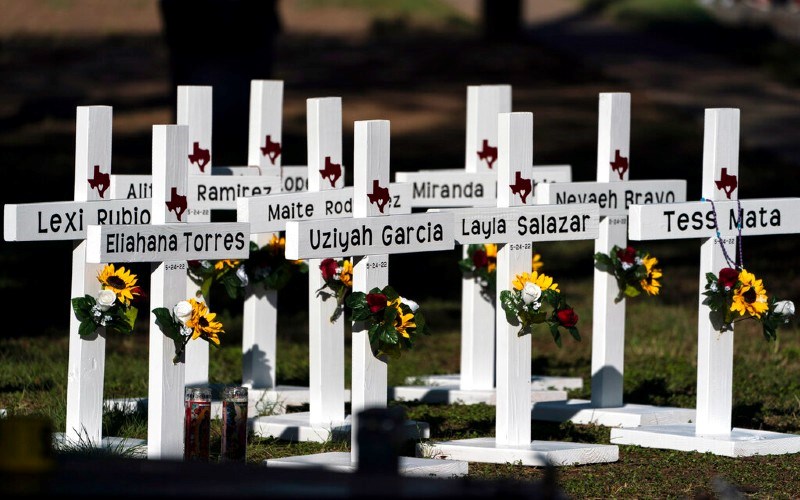| LATEST UPDATE ... Nearly 20 officers stood for about 45 minutes in the hallway outside the adjoining Texas classrooms where the gunman killed students and teachers this week before U.S. Border Patrol agents unlocked the door to confront and kill him, authorities said Friday. Read more... |
Tuesday's shooting at a Texas elementary school resulted in the deaths of 19 children and two teachers – and the gunman himself. The massacre was the deadliest shooting at a U.S. school since a gunman killed 20 children and six adults at Sandy Hook Elementary School in Connecticut in December 2012.
Yesterday afternoon, a Texas law enforcement official reported the 18-year-old gunman entered Robb Elementary School "unobstructed" through a door that was apparently unlocked. That jibes with a statement from Lt. Christopher Olivarez of the Department of Public Safety who reported to CNN that the shooter "barricaded himself by locking the door and just started shooting children and teachers that were inside that classroom."
AFN talked with Gregory Shaffer, a retired Supervisory Special Agent of the FBI, a former member of the agency's elite Hostage Rescue Team (HRT), and a founding partner of Shaffer Security Group. With reports beginning to circulate that the shooter could have been in the school for more than an hour before being shot by the tactical team, he speculates that the perpetrator may have entered "a hardened classroom – possibly protected by bulletproof doors and windows and incredibly good locks."
If indeed that much time passed, it's plausible – according to Shaffer – that law enforcement could not breach the door or windows to the classroom.
Learning from the failures
With the investigation of the shooting in process and details yet to come out, Shaffer tells American Family News several important elements of the story can still be taken into consideration.
By Shaffer's estimation, both the school district and the school itself appeared to be well-prepared to thwart a mass shooting. For example, an adequate number of officers were within the school district, security staff were on site, and partnerships with other law enforcement agencies were in place, as were several other measures to protect students and teachers.

"The Uvalde Consolidated Independent School District looks like they did all the right things," Shaffer points out. "But we need to take a real hard, critical look at those things and measure their effectiveness – because, obviously, there were some failures."
At this juncture, Shaffer – an expert on active shooter situations – says it's time to be "hypercritical of what their security measures were, determine how they failed, and come up with some solutions to fix it."
Shaffer argues that experts need to be spending more time talking about prevent, rather than response. "Once the shooting happens, everyone knows to run, hide; or fight or to escape, evade, or engage," he points out.
Also of critical importance, he says: What plans are in place to prevent the shooting from happening in the first place?
"One of the concerning issues in today's security for schools is the use of the school building as a perimeter," he explains. "That perimeter needs to be extended outward."
Shaffer describes an inner ring and an outer ring to that perimeter. "The inner ring is inside the walls [of the building]," he explains, "while the outer ring could be some kind of fence line that is patrolled by people or with cameras."
And while it's clearly a priority that the shooter be kept from getting inside the school, an extended perimeter – even if a shooter were able to make his way into the building – would allow teachers time to lock doors and other security measures to kick in. As a result, Shaffer explains hardened classrooms would also become more effective.
Even with established perimeters in place, he acknowledges "the problem is a multi-faceted problem … and there's no magic bullet for it."
As for other deterrents: "Trained school resource officers and an armed response are big keys to success in these kinds of situations," Shaffer suggests. "Active shooters, by and large, are just cowards – and hypervigilant armed officers are a good deterrent."
Equally important, he says, mental health concerns must be addressed better than they have been in the past – and existing gun laws need to be enforced without infringing on Second Amendment rights.
Of note, The Associated Press reports today that a bipartisan group of senators have restarted "gun control" talks and have narrowed the discussion to a few ideas, such as expanded background checks or red flag laws that keep guns away from people who could do harm.







